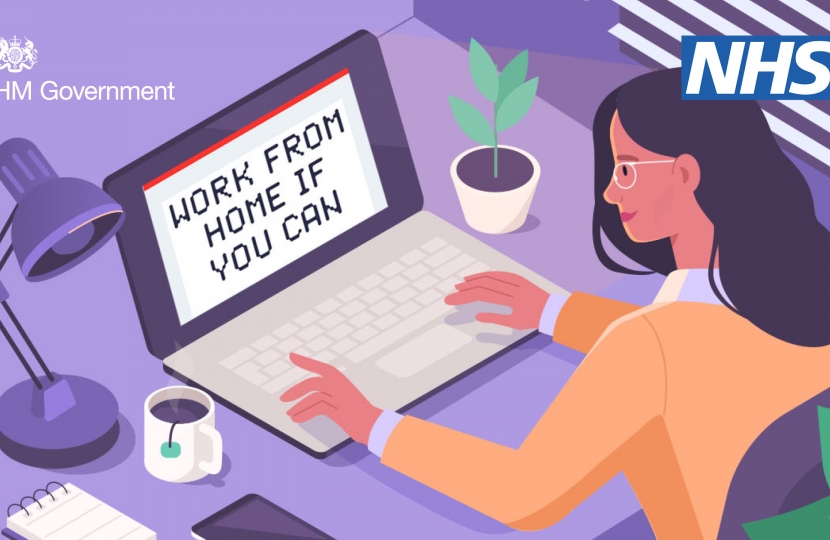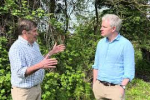
My inbox is pretty polarised about the new restrictions. Some constituents, concerned about personal liberty and about jobs, point to the still-very-low rates of hospitalisation and death (especially in Wiltshire) and say the government has gone way too far. Others point out that by the time these rates start climbing it’ll be too late to stop a deadly second wave, and so we need even stricter measures now to save lives later.
My inbox is not generally representative of public opinion at large. Indeed, polling shows that apart from the vocal minorities at each extreme, most people are somewhere in the middle about whether, and how much, to lock down our society and economy, with the majority favouring at least some increase in restrictions at this time. This is broadly where the government is too. After what must have been an intense discussion in No 10 last week, the PM has decided on a limited rather than full-blown lockdown.
I say this to make the point that we are all in the dark together. The fact is we don’t understand this disease, and no human mind or algorithm can compute the dynamic effects - on people’s health, on society, on the economy - of any particular combination of measures. Anyone who says they know what we should do should have their opinion discounted, on the grounds of delusions of wisdom.
Internet experts aside, we are really arguing about how to apply the precautionary principle: what’s the safest way to navigate through the darkness, keeping in mind all considerations including our long-term economic and social wellbeing? What follows is all I can say with confidence.
Hardly anyone says we should simply let Covid-19 rip. This is presumably contestable, but the Government’s own cost-benefit analysis in July calculated that with no mitigations at all - no social distancing, let alone the lockdown we had - there could have been up to 1.5 million excess deaths. This isn’t a disease we can just ignore. It’s between five and ten times more lethal than the flu. Five per cent of over 65s who catch it will die. Yes, many of those will be people who were ill already. But they too deserve to see out their allotted span, and for many we are talking about a difference of years.
The national lockdown slowed transmission of the virus (or ‘squashed the sombrero’). It bought us time to build up NHS capacity and to study the disease more closely, leading to improvements in treatment (the death rate of hospitalised patients has halved since March) and getting us closer to a vaccine.
However, it appears likely that the peak of the pandemic had passed by the time the lockdown began. Sweden’s first wave of infections stopped around the same times ours did, without everyone staying indoors for three months. And it can certainly be argued that if the lockdown did reduce transmissions and therefore deaths, these have simply been postponed rather than prevented. As we open up again, so infections peak again, as we are seeing. New York, which had a terrible first wave, seems to have been spared a second one, because about 20 per cent of the population has now had the virus, enough to slow the spread this time round
We must also factor in the excess deaths caused by the lockdown, and by the ‘protect the NHS’ policy (which really meant, ‘save the NHS for Covid patients’). One estimate by lockdown-sceptic scientists suggests 60,000 people (more than the Covid-19 toll so far) will die from cancer because they didn’t or couldn’t access medical treatment on time. Add to this the social cost to extended families (grandparents and aunts and cousins) forced to stay apart this winter, and the long-term scarring effects, especially for young people, of a recession induced by the decimation of retail.
So what is the right way forward?
The choice between ‘suppression’ and ‘mitigation’ is one between lockdowns based on ‘place’ and those based on ‘people’. Either we seek to suppress the virus by reducing interactions within the whole population of a particular place (including, in the worst case scenario, the whole country) or we try to mitigate the effects of the pandemic by shielding those people at particular risk of death if they catch the disease. The former is more or less what the health and science establishment, including those advising the government, advocate. The latter - ‘segment and shield’ - is the prefered option of certain rebel (though distinguished) scientists, assorted libertarian and contrarian commentators, and many ordinary people distressed by the restrictions on economic and social life.
This argument is very persuasive. Almost ninety percent of Covid-19 deaths are among people aged 65 and over. For everyone else, the risk seems manageable, and for children and young people it is almost negligible. Surely, then, we just look after the old folk, and let everyone else get on with their lives?
The answer to this is entirely determined by how easy or tolerable it is to shield the older generation, and how long it will be necessary for. Shielding the elderly sounds simple. But this option is only proposed because many old people - especially those from well-off families - live on their own. In poorer and more family-centric communities, especially immigrant communities, it is more usual for the elderly to live with their adult children and their grandchildren. This is an admirable model we need more of, though in terms of Covid-19 transmission it is a problem.
We could (and should, if we went down this route) massively support everyone who has to shield. Government could subsidise multi-generation households financially, including to rent a flat for the older members if necessary, or for some others of the household who need to go to work while the rest shield with the old folk in the family home. Care homes should be protected with a ring of steel (while allowing Covid-free family members to visit!). Just as important, civil society could mobilise to offer practical and social support to everyone shielding. No-one should be left lonely and anxious. We can and should do a huge amount to help shielders stay connected, and the experience of the lockdown is that communities have enormous latent capacity to look after shielding neighbours (last week I published a report for government exploring how we can sustain the community spirit of the lockdown).
But would it work? The elderly were protected during the national lockdown because infections in the community remained low. It is thought that only about seven per cent of the population has had the virus so far. ‘Segment and shield’ will mean anyone young and healthy will be at greater risk of catching it. Infections in the community will climb steeply. For most young and healthy people catching Covid-19 will be no problem; no doubt the NHS will cope; and this way we’ll steadily acquire the fabled herd immunity which is ultimately the way a population overcomes an epidemic.
But meanwhile, for the people we need to protect, the risk will become greater. Will the shield hold against a higher tide of infections lapping at their doors? Will we have to strengthen the shield even more - encasing homes in white tenting like the little boy’s house in E.T., and banning all contact with the outer world except in hazmat suits? Or will we, on libertarian grounds, let the elderly decide for themselves how much to shield, and take their chances - now that we have made those chances quite considerably worse?
A final point of challenge to the herd immunity doctrine: what if one’s immunity after having Covid-19 doesn’t persist for long, as we assume but cannot prove, so the herd doesn’t get more resilient with time, but steadily weaker?
People who advocate this path need to know what they are arguing for. They are suggesting leaving the elderly, and the poor, in a netherworld of extended isolation, subject to greater risk of infection and death than if we all joined them in staying at home for a few weeks or months. This might be the right thing to do. We can’t save every life just as we can’t save every business or job. We can’t ‘beat’ coronavirus. Even a vaccine might not be fully effective, so it’s not a question of simply waiting for the cavalry to arrive - it might never come.
To return to my point at the start: we’re in the dark. We can’t be sure what will work. And that’s why my overall suggestion for government isn’t to change policy. On balance I think they’re getting it right by focusing on ‘places’ not ‘people’ - rather than ‘segment and shield’ a particular class of citizen, they are implementing the minimum restrictions possible nationally (the rule of six) with stricter measures for the areas showing high rates of infection. Their view is that, without restrictions, an exponential rise in infections is mathematically inevitable; so the only thing to do is to rapidly increase test and trace capacity and to suppress transmissions until a vaccine arrives, which it could within months.
I accept that if the ‘places’ approach doesn’t work, and we seem condemned to a long period of living with high rates of infection, a switch to the ‘people’ approach might become necessary.
My suggestion is that we need transparency about the data and the reasoning behind decisions; that these decisions should be made on the basis of as wide a consultation as possible - including, where possible, with Parliamentary approval; and that the implementation of the decisions should rely, as far as they can, on the civic instincts of a free people. I don’t like the authoritarian flavour of the new rules, but I accept official analysis of public opinion shows that the law or the threat of it is necessary. I do think that the more the country can see the workings-out, and even be part of the conversation that contributes to the rules, the more we’ll understand them and support them.





